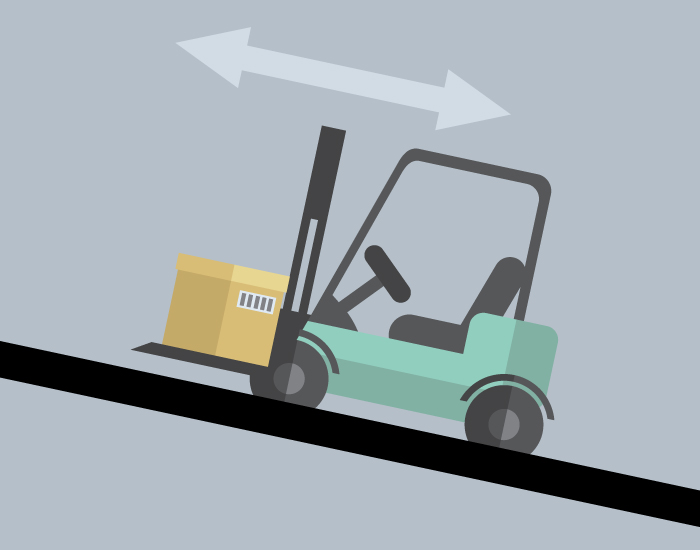We use cookies to make your experience better. To comply with the new e-Privacy directive, we need to ask for your consent to set the cookies. Learn more.
Safety Tips for Operating Lift Trucks On and Around Dock Ramps
In most warehouses, loading docks are buzzing hubs of activity. They're also dangerous places to operate a forklift, and workplace safety organizations have developed a wide range of regulations and recommendations to keep workers safe on and around the dock. 
Some of these standards include:
- OSHA Standard 1910.22 Walking-Working Surfaces
- OSHA Standard 1910.176 Material Handling
- OSHA Standard 1910.178 Powered Industrial Trucks
- ANSI/ITSDF B56.1-2012 Safety Standard for Low Lift and High Lift Trucks
- ANSI/ASSE A1264.2-2012 Standard for the Provision of Slip Resistance on Walking/Working Surfaces
Dock ramps allow forklifts to safely travel from dock to ground level, but operators should exercise a little extra caution to prevent costly spills and dangerous falls when traveling to and from dock-level. Here are a few tips, culled from the standards listed above, that every forklift operator should follow when navigating a dock ramp.
-
Keep away from the edges of the ramp.
This one may seem obvious, but you'd be surprised how easy it is to get careless after hundreds of trips up and down the dock ramp. Choose a ramp with high, durable curbs that can stop a straying lift truck. The BHS Dock Ramp (DR) uses 8" steel curbs to keep forklifts on a straight and narrow path.
-
Reduce speed when descending the ramp.
Stopping distance increases when you're traveling down a grade, especially with a full load. Compensate by taking it slow on your way down the ramp. Come to think of it, you can take your time on the way up, too — ramps are much easier to navigate at a casual pace.
-
If your ramp has a grade of 5 percent or more, keep unloaded forks pointing down-grade.
This may require backing up the ramp when you ascend to dock-level, which is counter-intuitive — but just ask the folks at the American National Standards Institute. The ANSI codes concerning 5-plus percent grades recommend fork-down travel for unloaded lift trucks.
-
If you're carrying a load, position the load up-grade.
Again, that may mean backing down the ramp when heading toward ground-level. Keep the load as low as possible during travel.
-
Don't make any turns on the ramp.
The ramp runs straight up and down — so should all forklift traffic.
-
Keep dock ramps clean, dry, and free of obstacles.
Any obstacle on your ramp will drastically increase your chances of an accident.
-
Pedestrian ramps should be fitted with guardrails.
Optional handrails convert the BHS Dock Ramp (DR) from a forklift travel path into a safe, convenient passage for pedestrians from the ground to the dock.
-
Make sure your dock ramp is secured before driving on it.
The BHS Dock Ramp features two anchors at the base for an extra-secure bond where the ramp meets the ground.
These tips should allow qualified forklift operators to stay safe on dock ramps, and safer facilities are significantly more productive. Similar tips can be applied to ground-to-truck ramps, which are indispensable if you need to move pallet loads into a trailer. The BHS Yard Ramp (YR) is a durable, solid steel ramp for piloting fully loaded lift trucks into and out of truck trailers.
For more tips on lift truck safety, browse the ANSI/ITSDF B56 codes here, or check out OSHA's forklift eTool.
References:
“ANSI/ITSDF B56.1-2012 - Safety Standard For Low Lift and High Lift Trucks.” Itsdf. Industrial Truck Standards Development Foundation, 23 Feb. 2012. PDF. 9 Sept. 2015.
“Handling Materials - General - 1910.176.” OSHA. Occupational Safety and Health Administration, United States Department of Labor, 24 Oct. 1978. Web. 9 Sept. 2015.
“Loading Dock Safety Checklist.” Libertymutualgroup. Liberty Mutual Insurance, Jan. 2013. PDF. 9 Sept. 2015.
“Powered Industrial Trucks - 1910.178.” OSHA. Occupational Safety and Health Administration, United States Department of Labor, 3 Apr. 2006. Web. 9 Sept. 2015.
“Walking-Working Surfaces - 1910.22.” OSHA. Occupational Safety and Health Administration, United States Department of Labor, n.d. Web. 9 Sept. 2015.
